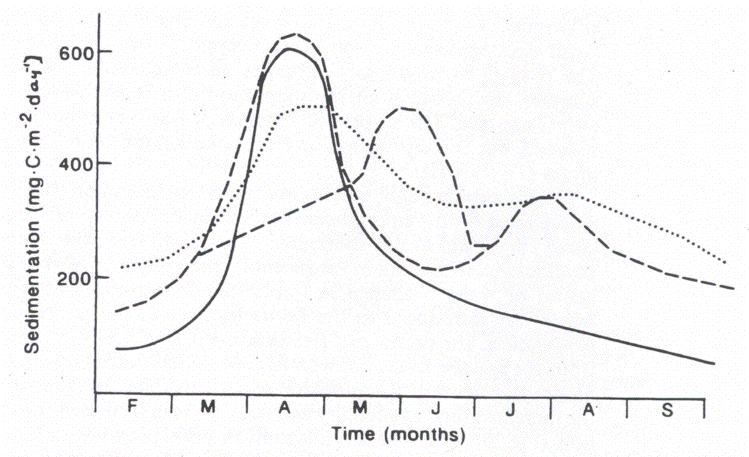


 |  |  | 8.8 Seasonal variation in vertical export |
Considering the seasonal flux of organic matter in various coastal settings three major modes can be distinguished: one-pulse, multi-pulse and in eutrophicated regions `buffered' systems [488]. As an example, we present data from west-Norwegian fjords (Figure 10). Non-eutrophicated land-locked fjords represent simple one-pulse systems, where new production, suspended biomass and sedimentation give rise to one major, annual pulse during spring. The relative amplitude of the seasonal signal in flux of organic matter is large, but the average sedimentation rate is low. Eutrophicated land-locked fjords show also seasonal variability in organic matter flux, but the relative amplitude of new production, suspended matter and sedimentation is lower (Figure 10). The average sedimentation rate, however, is high. The variability in such ecosystems is `buffered' by the continuous supply of allochthonous nutrients. Eutrophicated land-locked fjords are mainly one-pulse systems, but depending on the supply of nutrients from fresh water run-off, sewage etc. and climatic conditions, several minor summer and autumn blooms may develop. They may thus turn into two- or multi-pulse systems (Figure 10). Open fjords are complicated multi-pulse systems. Pulses in spring and autumn are normally found. However, upwelling of nutrient rich deep water can introduce additional pulses to the system at any time, but normally during late spring and early summer (Figure 10). Also, accumulated biomass can be removed from the fjord by large-scale exchange of water. In multi-pulse systems advection represents the most significant element. Comparing the dynamics of primary production and sedimentation in fjords renders, therefore, difficult because of the differences in time and space scales of these processes. Primary production is usually estimated in terms of litres and hours, sedimentation, however, integrates the vertical flux at a given depth over the time of trap deployment and is expressed in terms of square meters and days. While the produced biomass can stay in the fjord or is dispersed in adjacent bodies of water, sediment traps might catch organic particles that have been produced and altered throughout the coastal zone. If advection is significant in fjords, the locally measured primary production and sedimentation rates might have little in common, but rather reflect the general productivity and vertical flux regime in all parts of the coastal zones, from the innermost reaches to the open shelf. This has also implications for eutrophication. Eutrophication-derived suspended biomass may be introduced into a non-polluted region from outside or local eutrophication signals may be exported to unpolluted regions.

Ecosystems that receive nutrients continuously or pulsed differ with regard to the pelagic-benthic coupling. Pulsed nutrient addition may cause a higher build-up of phytoplankton biomass, a larger temporal mismatch between herbivores and phytoplankton biomass and a higher sedimentation rate of biogenic matter. This was tested in enclosures [450]. Each enclosure received the same total amount of nutrients, but the nutrients were supplied at four different intervals ranging from one single load to continuous additions. Spring bloom-like systems developed where nutrients were added in one or two pulses as they were characterised by high primary production, high suspended biomass of chlorophyll a (Chl a) and particulate organic carbon (POC) and high sedimentation rates. In contrast, the seawater enclosures receiving nutrients about every third day or in a continuous supply resembled regenerated systems with low concentrations of suspended Chl a and POC and with low and stable loss rates. The frequency of nutrient additions had a strong influence on the development of the phytoplankton and vertical flux of biogenic matter as pulsed nutrient addition resulted in the highest vertical export.
 |  |  | 8.8 Seasonal variation in vertical export |